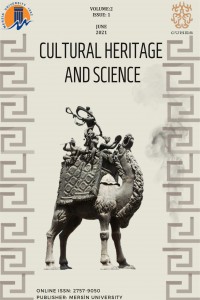The Contribution of Archaeological Surveys on the Perception of Cultural Heritage: Cilicia As a Case Study
Abstract
In archaeology, the primary contribution of surveys to cultural heritage is that it provides an alternative to excavation. Thus, it ensures that the destruction of cultural heritage by excavation is avoided. This study first addresses the relationships between archaeology and cultural heritage. A description of archaeological information on the history of surveys are made. Furthermore, the contributions of surveying to cultural heritage are conveyed. Cilicia Region is the geographical limitation of the research. The material of the study is diversely selected from surveys carried out in the Cilician Region. Interdisciplinary works contributing to archaeological surveys are also presented. Many of them such as geography, geology, hydrology, Geomatics Engineering, epigraphy contribute to this research. In addition, common application methods (GIS, 3D Modelling, Photogrammetry etc.) of this studies are also discussed in this study. The implications of all these studies for cultural heritage are given. Temporally, the study covers the Hellenistic, Roman and Byzantine Periods. The final section concludes the study by providing a general framework for the benefits of surveys for cultural heritage.
Keywords
Archaeological Survey Cultural Heritage and Surveys Survey interdisciplinary approaches Cilician Surveys Surveys and using GIS Survey and 3D Modeling Surveys and photogrammetry Surveys and remote sensing methods
References
- Akurgal E (2005). Anadolu Kültür Tarihi. Ankara.
- Aşkın E (2006). Comparison of Roman Period Cities in Cilicia and Lycia Regions in terms of Urban Plan and Architecture. Master’s Thesis, Mersin University, Institute of Social Sciences, Mersin, 320p (in Turkish)
- Aydınoğlu Ü (2010). Erdemli ve Silifke Arasında Kentleşme ve Tarımsal Organizasyon 2008 Yılı Araştırması, 27. Araştırma Sonuçları Toplantısı 3. Cilt, 97-109.
- Aydınoğlu Ü (2020). Survey of Urbanization and Rural Settlements in Rough Cilicia during Antiquity. Cultural Heritage and Science, 1(1), 1-6.
- Beaufort F (1818). Karamania, or A Brief Description of the South Coast of Asia Minor and of the Remains of Atiquity. Londra.
- Erten E, Özyıldırım, M & Akçay T (2009). Olba 2008 Yılı Yüzey Araştırması. 27. Araştırma Sonuçları Toplantısı, 3. Cilt, 51-69. Ankara.
- Gaifmann M (2008). The Aniconic Image of the Near East. In the Variety of Local Religious Life in the Near East in the Hellenistic and Roman Periods (Ed. T. Kaizer). Brill:Leiden.Boston.
- Kalaycı T (2020). Arkeolojide Mekansal Teknolojiler: Uzaktan Algılama ve Coğrafi Bilgi Sistemleri. In Arkeolojide Temel Yöntemler (Eds. S. Ünlüsoy, C. Çakırlar, Ç. Çilingiroğlu). Ege Yayınları: İstanbul. 69-107.
- Kaplan D, Alkaç E, Yıldırım Ş & Evgen G (2018). Tarsus Hinterlandı Arkeolojik Yüzey Araştırması (2016-2017), Araştırma Sonuçları Toplantısı, 36/1, 429-438.
- Kaplan D, Yıldırım Ş, Evgen G & Göçmen (2020). Tarsus Hinterlandı Arkeolojik Yüzey Araştırması-2018, Araştırma Sonuçları Toplantısı, 37/1, 393-398.
- Kipfer B A (2000). Encyclopedic Dictionary of Archaeology. Newyork: Springer Science and Business Media.
- Koparal E (2020). Arkeolojide Yüzey Araştırmaları: Yöntem, Tarihçe ve Uygulama. In Arkeolojide Temel Yöntemler (Eds. S. Ünlüsoy, C. Çakırlar, Ç. Çilingiroğlu). Ege Yayınları, İstanbul, ss. 109-158.
- Maschner H D G (1996). Geographic information systems in archaeology. In New Methods, Old Problems: Geographic Information Systems in Modern Archaeological Research. Southern Illinois University: Carbondale, IL, USA, 1996; pp. 1–21; ISBN 0881040797
- Özdoğan M (2006). Arkeolojinin Politikası ve Politik Bir Araç Olarak Arkeoloji. İstanbul: Arkeoloji ve Sanat Yayınları.
- Özdoğan M (2011a). 50 Soruda Arkeoloji. İstanbul: Renk Basım Yayın.
- Özdoğan M (2011b). Arkeolojik Kazılar Bilimsel Çalışma mı? Toprak Hafriyatımı?. İstanbul: Arkeoloji ve Sanat Yayınları.
- Özdoğan, E. (2015). Current research and new evidence for the Neolithization process in Western Turkey. European Journal of Archaeology, 18(1), 33-59.
- Özyıldırım M & Ünalan H (2011). Isavria Dağlarında Hıristiyan Manastırcılığının Bir Örneği: Olba Manastırı. Seleucia, (1), 137-166.
- Özyıldırım M &Kaplan D (2015). Ortadoğu’da Kültürel Tahribat. Özne: Felsefe Bilim ve Sanat Yazıları, 23, 169-181.
- Sayar M H (200). Kilikya’da Epigrafi ve Tarihi Coğrafya Araştırmaları 1999. Kültür Varlıkları ve Müzeler Genel Müdürlüğü Araştırma Sonuçları Toplantıları 18-1, 275-288.
- Smith L (2010). Archaeological theory and the politics of cultural heritage. London: Routledge.
- Şimşek G (2014). Kültürel Miras ve Yeni Biçimlenme Süreci Üzerine Bir Değerlendirme. 21. Yüzyılda Eğitim Ve Toplum Eğitim Bilimleri Ve Sosyal Araştırmalar Dergisi, 3(8), 67-92.
- Varinlioğlu G (2012). Boğsak Adası Yüzey Araştırması 2011 (Survey on the Boğsak Island 2011). Anmed Anadolu Akdenizi Arkeoloji Haberleri 2012/10, 137-141.
- Varinlioğlu G (2012). Boğsak Adası Yüzey Araştırması 2013 (Survey on the Boğsak Island 2011). Anmed Anadolu Akdenizi Arkeoloji Haberleri 2014/12, 135-139.
- White G G & King T F (2016), The Archaeological Survey Manuel, London: Routledge.
- Yakar M &Doğan Y (2018). Gis And Three-Dimensional Modeling For Cultural Heritages. International Journal of Engineering and Geosciences (IJEG), Vol; 3; Issue; 2, pp. 50-55, June, 2018, ISSN 2548-0960.
Details
| Primary Language | English |
|---|---|
| Subjects | Archaeology |
| Journal Section | Research Articles |
| Authors | |
| Publication Date | June 1, 2021 |
| Published in Issue | Year 2021 Volume: 2 Issue: 1 |



 Cultural Heritage and Science (CUHES) journal is licenced under Creative Commons Attribution-ShareAlike 4.0 International License.
Cultural Heritage and Science (CUHES) journal is licenced under Creative Commons Attribution-ShareAlike 4.0 International License.